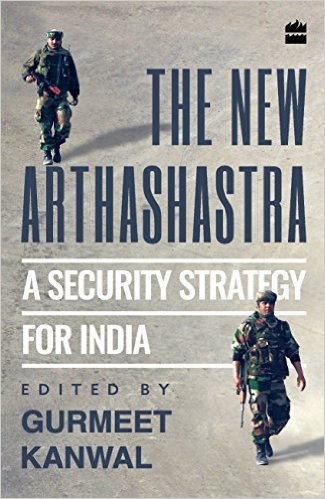The Arthashastra is an insight into the political thoughts of Kautilya. The book was written around 250 BCE. The most interesting idea presented in the book is the Mandala theory of interstate relations. Mandala represents the universe and our own kingdom is in the centre of a circular Mandala. The area surrounding the Mandala should be considered territories belonging to our enemies. The circle surrounding our enemies’ territories will be the allies of our enemies. The Mandala theory goes on to analyse 12 concentric circles and how to deal with each state according to the layer they belong to in the Mandala construct. The book covers peace, war, neutrality, preparing for war, seeking protection and diplomacy.
The New Arthashastra is a security strategy for India that has 20 chapters with twenty authors covering the entire spectrum of the subject. The chapters need detailed study to understand the complexities of India’s security. Currently India has no National Security Strategy. Accordingly our decision making is based on the expertise of individuals and is often slow and reactive. The book certainly provides a document to the Government to understand and resolve security problems.
It merits importance to give an overview of the Chapters. In the Preface Professor Gautam Sen explains the Conceptual underpinnings of National security Strategy. The Introductory Chapter dealing with Defence Policy and Management of National Security is by General V P Malik. The chapter provides A Suggested Outline for a National Security Strategy. He is emphatic that we change our mindset and attitudes to take on the role as a regional power. The next Chapter is on the International Experience by General Dhruv Katoch. It covers the Defence policies of major powers. The third and fourth Chapters by General BS Pawar and General Aditya Singh cover the Threats, Challenges and Vulnerabilities as also the National Security Objectives. Chapter 5 by C Raja Mohan deals with Beyond Non Alignment, New Imperatives for Defence Diplomacy. To operate in distant waters, he cites the need for a range of special political relationships and military partnerships. He foresees a greater regional and international demand for India’s military services, support and cooperation. Despite the entrenched resistance to security sector reform, the new imperatives of national security are likely to prevail over the inherited ideology of non alignment.
Chapter 6 by Vikram Sood deals with Future of Intelligence where he writes about the technological and psychological challenges in this field and the need forstrengthening arms of intelligence.Manpreet Sethi in her Chapter on Nuclear Deterrence speaks about India’s Nuclear Doctrine. She recommends capability build up and greater transparency of the existence of Strategic Forces Command. Ambassador Kanwal Sibal covers aspects pertaining to Managing External Threats in Chapter 9 of the book. He devises a coherent strategy in which he recommends a strong naval power, an indigenous defence industrial base, improvement of our internal security apparatus to deal with Islamic radicalism and the need to maintain strategic autonomy.
Admiral Arun Prakash has analysed Maritime Security remarkably well in Chapter 9. He advocates a need to revise our maritime Strategy, emphasis on coastal security, ship building incorporating advanced technology, seabed exploration in our Exclusive Economic Zone, interaction with foreign Navies and evelopment of island territories as also a strategic vision for the future. General Ata Hasnain outlines the Counter Proxy War Strategy in Jammu and Kashmir in Chapter 10 of the book. He explains the Contours of Indian response which should be focussed on Intellectual Understanding, Financial Control of terrorist finding, de radicalisation, exploiting social media and other measures.
The next part of the book focuses on Internal Security, Outer Space, Cyber Warfare, Research and Development, Economic Warfare, Defence Production, Grand strategy and the Final Chapter on the nations Security Strategy. Dr Ajai Sahni in Chapter 11 discusses the way to manage Internal Security challenges. He concentrates on improving policing and intelligence as also addressing external sources of internal threats and the need to resolve Centre State issues. The aspect pertaining to Financial Support is aptly dealt by Amit Cowshish. He analyses the Budgetary Allocation and the need for ensuring that the Armed Forces remain at the highest level of preparedness at all times. General Davinder Kumar tackles aspects dealing with Outer Space in Chapter 13 and Cyber Warfare in Chapter 14. He comprehensively carries out an analysis of the issues involved in these two spheres.
The aspects concerning Defence Research and Development Strategy is covered by Professor Amitav Mallik. He covers the strategy but does not bring out why the DRDO misses deadlines and the remedial action for the same. The need for a different organisation focussing only on Critical technologies is not discussed as a part of the strategy. Energy security is aptly covered by Shebonti Ray Dadwal in Chapter 17. It may be pertinent to note that cost of renewable energy will come down in years to come. In all our platforms this would make a difference. Indigenisation of Defence Production in Chapter 18 is authored by Commodore Shridharan Shekhar. A complex subject which is very well covered and addresses the reasons for our current state of affairs. It would be pertinent to include the user who forms the start point for the acquisition process. There is currently a design Bureau with the Army and the Navy which can play a very important role in the process of indigenisation. The Air Force may also consider having a design Bureau like the other two services.
Chapter 19 deals with Contours of India’s Grand Strategy by General Raj Shukla. He has outlined the process of creating a grand Strategy for India; he has recommended a consultative process between the think tanks, National Security Council and Parliamentary Standing Committee. The simpler process would be it is made by one think tank and the same is vetted by these organisations and thereafter put up to the Cabinet Committee on Security for approval.
The last Chapter is by the Editor, Brigadier Gurmeet Kanwal in which he justifies the need for a National Security Strategy. His inference is right that the Ministry of Defence, Ministry of Home and Ministry of External Affairs have different planning cultures and processes. There is a need for synergy between these three ministries, the National Security Adviser and the three Services. A National Security Strategy encompassing all these aspects definitely harmonises our thinking process and leads to superior decision making. The Chapter gives a gist of the substance discussed in the preceding Chapters and makes a holistic document. This Chapter is really a must read for all the three Service Headquarters, Ministries of Defence, Home, External Affairs, the National Security Adviser, Parliamentary Standing Committee of Defence and Prime Minister’s Office.
Though the book is an outstanding piece of strategic literature a few issues merit attention for the reader. The book misses out the strategic role played by our Defence Attachees who are able to provide valuable inputs for forming the strategy to deal with our foreign countries. After all they are located in mandalas which need to be addressed. The next issue is Civil Military relationship. The chasm increases day by day and needs to be directly addressed. The Business Rules make the Defence Secretary responsible for the defence of the country. Rightfully, the Raksha Mantri should be responsible for the defence of the country. It would be nice if there was a chapter on Jointness which would be the key to victory in operations being undertaken currently.
Other areas of disagreement pertain to the DRDO which needs to be totally revamped to meet the user needs, an increase in the defence budget for modernisation, intelligence sharing needs improvement and agencies like the ISRO need to look at requirement of satellites for the Army and Air Force. Two areas which need to be thought of are Surveillance to include Reconnaissance and Target Acquisition as also the importance of the private sector which needs a level playing field in relation to the public sector units for defence production.
Overall Brigadier Gurmeet Kanwal and his team have produced an excellent book which must be read by all officers of the three Services and officers serving in the Ministries of Home, Defence, External Affairs, Prime Minister’s Office and National Security Council Secretariat as also by the Parliamentary Committee on Defence.
Reviewed by Maj Gen P K Chakravorty










